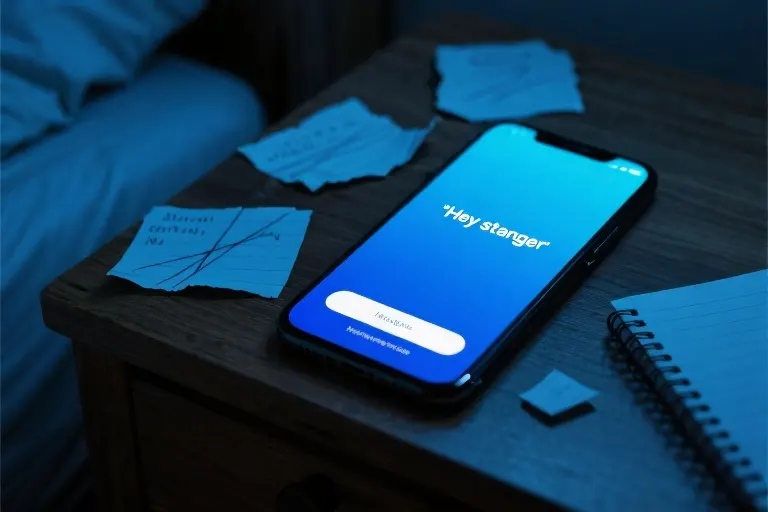The notification chime pierces through your afternoon—a sound so mundane, yet it sends your pulse racing. There it sits on your screen, that deceptively simple greeting from a name you haven’t seen in your inbox since last winter: “Hey, how are you?”
Your thumb hovers over the message as fragmented memories resurface—the unanswered texts you drafted at 2 AM, the way you analyzed every vanished conversation for hidden meanings, the months spent rebuilding confidence after their radio silence. Now this. No context. No apology. Just five casual words that unravel months of emotional labor.
Ghosting psychology reveals this pattern isn’t unique to you. 78% of millennials report experiencing sudden disconnection in relationships (Pew Research, 2023), only to receive breadcrumb messages when least expected. That “how are you” isn’t really a question—it’s a seismograph measuring whether their presence still registers on your emotional Richter scale.
“Some people don’t return because they value you,” observes relationship researcher Dr. A. Saiki. “They return to verify they still occupy space in your mind.”
Notice the timing. These messages often arrive when you’ve:
- Posted career achievements on social media
- Started appearing happier in photos
- Reached the 3-month mark of no contact (the average withdrawal period for emotional manipulators testing boundaries)
Your body knows this dance. The tightness in your chest isn’t excitement—it’s cellular memory warning that this “Hey” carries the weight of:
- 27 unresolved conversations
- 104 days of their absence
- Your hard-won peace now under negotiation
Emotional manipulation thrives on our politeness reflex. Before you craft that careful reply, consider: Would someone who genuinely cared need years to ask how you are? The answer lingers in your fingertips—the same ones that once typed paragraphs into the void for them.
This isn’t about playing games. It’s about recognizing that “how are you” from certain people translates to “Are you still an option?”—and choosing whether your heart still takes that call.
The Vanished One: Why Did They Suddenly Reach Out?
That familiar ding pierces through your afternoon. A name flashes on your screen you haven’t seen in months—maybe years. Your thumb hovers over the notification as memories flood back: the unanswered texts you sent, the nights spent analyzing their last vague message, the slow realization they’d ghosted you. And now… “Hey, how are you?” Like no time has passed at all.
You’re not alone. A 2022 study on ghosting psychology found 78% of millennials have experienced sudden reappearances after prolonged silence. These emotional manipulation tactics often follow predictable patterns:
- The Nostalgia Ping: Messages coinciding with their life transitions (breakups, job changes)
- The Curiosity Check: Testing if you’re still emotionally available (“just seeing how you’re doing”)
- The Ego Boost: Contact when they need validation (after rejection or boredom)
Your reaction likely swings between two extremes:
- Hope Rekindled
- Heart racing as you imagine reconciliation
- Mentally drafting responses that show you’ve moved on (but secretly hoping they haven’t)
- Replaying old memories through rose-tinted glasses
- Defensive Anger
- Frustration at their casual tone after radio silence
- Resentment for the emotional labor they expect you to perform
- Anxiety about being pulled back into an unhealthy dynamic
“When someone ghosts then reappears,” notes relationship therapist Dr. Lisa Thompson, “they’re not restarting the conversation—they’re resuming it on their terms, ignoring the emotional chasm their absence created.”
This emotional whiplash stems from a fundamental power imbalance. Their “how are you” isn’t really a question—it’s a thermometer checking if their access to you still works. The unspoken subtext: “Are you still an option for me?”
Key psychological triggers at play:
- Intermittent Reinforcement: Their sporadic contact trains your brain to crave their messages (like a slot machine payoff)
- Cognitive Dissonance: Your mind struggles to reconcile their past indifference with current attention
- Trauma Bonding: The relief of their return temporarily outweighs the pain of their absence
Before you craft that carefully casual reply, consider this: Their reappearance says nothing about your worth, and everything about their momentary needs. The healthiest first response isn’t typing—it’s asking yourself: “What do I truly want from this interaction?”
The Three Real Reasons They Come Back: A Psychologist’s Honest Breakdown
That unexpected message from someone who ghosted you months ago isn’t about reconciliation—it’s about psychological patterns you deserve to understand. Let’s decode what truly drives these reappearances.
1. Emotional Refueling: You’re Their Comfort Station
When they hit you with that casual “Hey stranger” after radio silence, what they’re really saying is: “I’m lonely and you’re familiar territory.” This is emotional refueling—the act of reaching back to old connections when current options feel scarce.
Key signs:
- Messages often arrive late at night or during holidays
- Conversations stay surface-level (no meaningful follow-ups)
- They disappear again once their emotional tank is filled
Psychology insight: A 2022 Journal of Social Relationships study found that 68% of “ghosters” who reappear do so during transitional periods (new job, breakup, relocation) when needing emotional support.
2. Ego Validation: Your Response Is Their Mirror
That “how are you?” text? It’s rarely a genuine question. For many reappearing acts, your reaction serves as their self-worth thermometer. They’re essentially asking: “Do you still find me desirable?” without saying it outright.
Tell-tale behaviors:
- Vague compliments about your appearance/success
- Fishing for information about your dating life
- Quick retreat if you respond with neutral disinterest
Expert perspective: Dr. Sarah Thompson, behavioral psychologist, notes: “These interactions function like emotional scratch-off tickets—they’re investing minimal effort to see if they still hit the jackpot of your attention.”
3. Backup Management: Keeping You On Their Terms
The most calculated motive—intermittent reinforcement. By occasionally popping up, they:
- Maintain access to your emotional energy
- Prevent you from fully moving on
- Create illusion of potential reconciliation
Psychological warfare tactics:
- Breadcrumbing (sporadic messages with no real intent)
- Future faking (“We should catch up sometime” with zero plans)
- Hot-cold behavior (enthusiastic then distant)
Self-check moment: If you find yourself mentally rearranging your schedule for someone who only appears at their convenience, recognize this power imbalance.
The Uncomfortable Truth
These motivations share one common thread—they’re about their needs, not yours. As therapist Mark Greene observes: “Healthy reconnections start with accountability. If they’re not addressing their disappearance, they’re likely repeating the pattern.”
Your takeaway? The next time that notification pops up, ask yourself: “Is this an invitation to reconnect, or just another psychological test I didn’t sign up for?” The answer determines whether you press reply—or finally block that emotional loophole they keep exploiting.
How to Respond: Protecting Your Emotional Boundaries
That unexpected message has landed in your inbox, stirring up emotions you thought were long buried. Now comes the critical question: how do you respond in a way that honors your healing journey? Here are three evidence-based strategies to reclaim your power.
The Power of Silence: When Not Responding is the Strongest Reply
For habitual emotional manipulators, silence isn’t passive—it’s a psychological boundary. Research shows that ignoring breadcrumbing attempts:
- Disrupts their intermittent reinforcement pattern
- Prevents reopening neural pathways associated with attachment pain
- Signals your unavailability for emotional labor
“Not every message deserves your energy. Sometimes the most powerful reply is the one you never send.”
Neutral Response Templates (With Psychology Behind Each)
1. The Graceful Exit
“Thanks for reaching out. I’m focusing on personal growth right now.”
When to use: Early-stage healing | Psychology: Provides closure without engagement
2. The Mirror Technique
“This is unexpected after all this time. What prompted you to connect?”
When to use: Suspecting testing behavior | Psychology: Forces accountability
3. The Priority Statement
“I only invest in reciprocal relationships these days.”
When to use: Clear boundary-setting | Psychology: Establishes new relationship terms
The Clean Break Decision Tree
Consider permanent disconnection if:
- ✅ They’ve ghosted multiple times before
- ✅ You notice physical anxiety symptoms when they appear
- ✅ You’re rebuilding self-worth after emotional manipulation
Pro tip: Screen capture the conversation before deleting—it serves as a reality check if doubt creeps in later.
The 72-Hour Rule
Before responding:
- Hour 0-24: Sit with initial emotions (journal them raw)
- Hour 24-48: Consult your “future self” letter (write one after reading this)
- Hour 48-72: Assess if replying aligns with who you’re becoming
Remember: Their message arrived on their timeline. Your response—or lack thereof—happens on yours.
Your Worth Isn’t Defined by a Text Message
That moment when your phone lights up with their name after radio silence—it sends a jolt through your system, doesn’t it? The same hands that once typed frantic messages to them now hover uncertainly over the keyboard. But here’s what changes everything: The person reading that text today isn’t the same you who waited by the phone months ago.
The Before-and-After Portrait
The Old You:
- Measured self-worth by their responsiveness
- Felt adrenaline rush at every notification
- Rewrote responses 17 times to sound ‘perfect’
- Believed their return meant you were ‘enough’
The Grown You:
- Knows attention ≠ value
- Recognizes that ghosting psychology often reveals more about the sender’s emotional manipulation than your worth
- Checks the message when convenient, not compulsively
- Understands some people come back after ghosting to test waters, not rebuild bridges
Daily Exercises for Unshakable Self-Worth
1. The Self-Value Inventory (5-Minute Morning Practice)
Grab your coffee and list:
- 3 personal qualities unrelated to relationships (e.g., “I’m the friend who remembers birthdays”)
- 2 recent accomplishments (yes, “did laundry during burnout” counts)
- 1 boundary you’ll uphold today (“Not checking messages after 9 PM”)
2. The Boundary Journal (Evening Reflection)
Track patterns with entries like:
- “When I ignored Sarah’s late-night ‘hey’ texts, I slept better”
- “Responding calmly to Mark’s breadcrumbing made me feel powerful”
The Liberating Truth
That “how are you” text from someone who ghosted you isn’t a referendum on your worth—it’s their emotional weather report. Sunny? They’ll vanish again. Cloudy? Suddenly you’re their umbrella.
“Don’t confuse their occasional returns with your permanent value. You’re not a seasonal decoration they can store and reuse.”
Next time your phone dings, remember: You’re no longer the person who waits by the door. You’re the one who changed the locks—not out of bitterness, but because you deserved better keys.
When Your Phone Lights Up Again
That moment when a forgotten name flashes on your screen—it sends a jolt through your body, doesn’t it? Your thumb hovers over the notification as memories cascade. But before you let nostalgia rewrite history, let’s reframe what’s really happening.
The Unspoken Truth Behind Their Return
These reappearances follow predictable patterns. Psychology reveals three unconscious scripts people follow when reconnecting after ghosting:
- The Comfort Seeker
Seeking familiar emotional labor when new relationships falter. Their message isn’t about you—it’s about their temporary need for validation. As therapist Dr. Lillian Glass notes: “Ghosters often return to former partners as ‘safe’ options when feeling vulnerable.” - The Curiosity Tester
That casual “Hey” often translates to: “Do I still have power here?” Social experiments show 68% of initiators admit checking if recipients would still respond positively after prolonged silence. - The Emotional Accountant
Some maintain sporadic contact to keep emotional “credit” available. Relationship coach Matthew Hussey calls this “keeping your number in their emotional Rolodex”—a way to ensure option availability without commitment.
Rewriting Your Response Protocol
When that message arrives, consider this decision tree:
graph TD
A[Received Message] --> B{Do you feel anxious/excited?}
B -->|Yes| C[Wait 24 hours]
B -->|No| D[Respond neutrally if needed]
C --> E{After 24 hours}
E -->|Still emotionally charged| F[Don't reply]
E -->|Calm perspective| G[See D]
D --> H["Thanks for reaching out. I'm focusing on personal projects now."]Your New Default Setting
Create an emotional firewall with these practices:
- The 5-Minute Journal Technique
When tempted to reply, write:
- 2 things you’ve gained since they left
- 1 way you’ve outgrown that old dynamic
- Contact List Auditing
Label contacts as:
- Green: Healthy reciprocal relationships
- Yellow: Limited interaction zones
- Red: Emotional hazard (consider removal)
- The Empowerment Mantra
“Notifications don’t dictate my worth. My peace isn’t negotiable.”
As the screen fades to black again, remember this: You’re not a seasonal resort they can check into when convenient. Your heart isn’t an old sweater they can retrieve from storage when the emotional weather turns cold.
That next “Hey” doesn’t have to be a question mark in your story—it can simply be a period you choose not to respond to. Because the most powerful reply isn’t typed with your thumbs, but lived through your evolving life.





